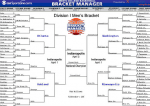 Josh Axelrod > University of Maryland > Freshman > Journalism, Photo by Rob Williams
Josh Axelrod > University of Maryland > Freshman > Journalism, Photo by Rob Williams
Predicting what the full bracket for March Madness will look is like trying to guess what type of food Lady Gaga will use for her next outfit. Joe Lunardi, ESPN’s resident bracketology expert, has been working overtime to predict what the field will look like for the 2011 NCAA Tournament.
His current bracket (as of February 21, 2010) has Ohio State, Kansas, Pitt, and Brigham Young as the four number one seeds. But nothing is ever set in stone of course. Ohio State just lost to Purdue, one of Lunardi’s two seeds. Duke has suffered some bad losses to teams like Virginia Tech and Florida State, but the Blue Devils are still in contention for a top seed. So is Texas; though losses to Colorado and Kansas State are not helping their case for a higher seed.
Some teams are more worried about making the tournament than pursuing a higher ranking. These “bubble teams” include Boston College, last year’s runner-up Butler, Michigan State, Washington, and Florida State, among others.
Of Michigan State, which has made the final four in the past two tournaments, Comcast Sports’ Dan McQuade says they’re out, citing too many losses.
One bubble team that no one would want to face is St. John’s. They already have huge wins against Georgetown, Notre Dame, Duke, and Pitt and are an impressive 7-7 against RPI Top 50 schools. McQuade thinks they are in.
Those wins become more impressive when you look at the quality of the Big East this season: Lunardi has eleven Big East schools joining the March Madness pool. The UConn Blog’s Andrew Porter had this to say about the Big East this season, but it is also appropriate for all of college basketball this season and especially the unpredictability of March Madness: “There is so much parity here it’s tough to predict what will happen on any given day.”



















